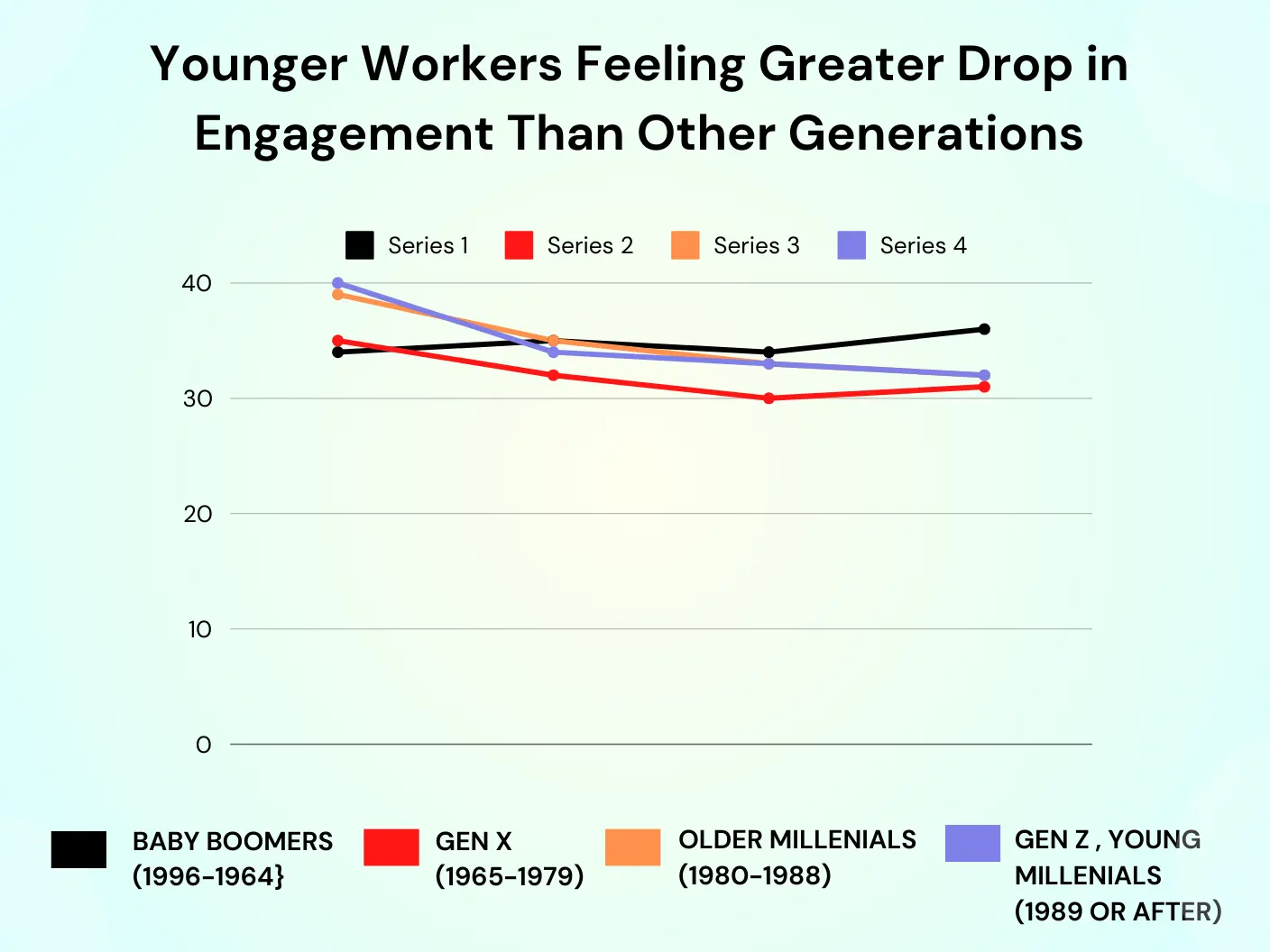
Bridging the Gap: Keeping Young Employees Engaged
The COVID-19 pandemic changed a lot about how we work. It made many people feel disconnected from their jobs. A recent study by Gallup shows that employees aren’t as engaged at work as they used to be before the pandemic. This is especially true for younger workers.
Older workers, known as Baby Boomers, are still engaged at work. However, Generation X and Millennials need help staying connected to their jobs.
Table of Contents
Baby Boomers Stay Engaged, Gen X and Millennials Struggle
Since March 2020, the number of engaged Baby Boomers has increased slightly. This means they feel good about their work. But for Generation X employees, there’s been a decrease in engagement. And Millennials, especially the older ones, are struggling the most. They feel less connected to their work and their employers.
Younger Millennials and Gen Z employees are also feeling less engaged than before. This shows that younger workers, in general, are having a tough time feeling connected to their jobs.
Age-wise, post-pandemic engagement statistics show that baby boomers are still engaged while younger workers feel the most cut off from their jobs and employers.
Source: Gallup insights
Millennials, who were born between 1980 and 1988, are the oldest generation that has experienced the most drastic fall in engagement. While the number of older millennials who are actively disengaged has climbed by five points, from 12% to 17%, the percentage of engaged older millennials has decreased by seven points, from 39% to 32%. Accordingly, the engagement ratio of older millennials has fallen from 3.3 to 1.9; there are just slightly more than two engaged employees for every actively disengaged one.
The number of actively disengaged employees has climbed by one point, from 13% to 14%, while the younger generation of millennial and Gen Z employees (born in 1989 or later) have seen a five-point fall in engagement, from 40% to 35%. This indicates that the engagement ratio of younger Gen Z and millennial employees has decreased from 3.1 to 2.5.
Understanding Why Engagement is Different?
Gallup studied what makes employees feel engaged at work. They found that since the pandemic started, many workers don’t feel like they know what’s expected of them at work. This lack of clarity affects everyone, no matter their age.
But younger workers feel it even more. They feel like they’re not cared for at work, don’t have enough chances to learn and grow, and don’t feel connected to their company’s goals. This makes them feel disconnected from their jobs and unsure about their future.
How to Help Younger Workers Stay Engaged?
To help younger workers feel more connected to their jobs, managers need to:
- Share a clear vision of the company’s goals and values.
- Support managers so they can better help their teams.
- Make it clear how much time young workers should spend in the office.
- Provide opportunities for learning and growth that fit each employee’s needs.
- Be flexible with work arrangements.
- Listen to and act on younger workers’ ideas.
By doing these things, managers can help young employees feel more engaged and loyal to their jobs. This not only helps the employees but also benefits the company in the long run.
How Creative Social Intranet Can Help Bridging the Gap: Keeping Young Employees Engaged?
Here’s a breakdown of how Creative Social Intranet can bridge the gap and keep young employees engaged:
Addressing Challenges:
Young employees often crave:
- Connection and Interaction: They want to feel part of a team and have opportunities to connect with colleagues.
- Meaningful Work: They desire to understand how their work contributes to the bigger picture.
- Quick and Easy Access to Information: They prefer information readily available on their preferred devices.
- Feedback and Recognition: They appreciate regular feedback and recognition for their contributions.
Creative Social Intranet Solutions:
- Social Features: Discussion forums, groups based on interests, and social media-like feeds foster connections and a sense of community.
- Interactive Content: Videos, polls, and interactive reports make information engaging and easily digestible.
- Mobile Accessibility: Access from any device allows young employees to stay informed and connected on the go.
- Gamification & Recognition Tools: Points, badges, and leaderboards for achievements motivate and acknowledge contributions.
- Knowledge Sharing Platforms: Wikis, document sharing, and mentorship programs facilitate knowledge transfer and career development.
Bridging the Gap:
By providing these features, Creative Social Intranet addresses the needs of young employees, fostering:
- Increased Engagement: Interactive features and a dynamic environment keep young employees interested and involved.
- Improved Communication: Two-way communication allows for open dialogue, feedback exchange, and a sense of being heard.
- Enhanced Collaboration: Group features and knowledge-sharing platforms break down silos and encourage teamwork.
- Stronger Company Culture: Connection and recognition create a positive and inclusive work environment where young employees feel valued.
Overall, the Creative Social Intranet becomes a bridge between young employees and the organization, fostering a more engaged, collaborative, and successful workforce.
Categories: